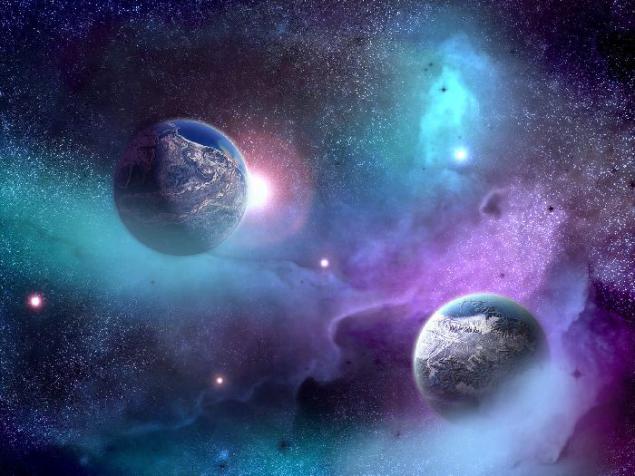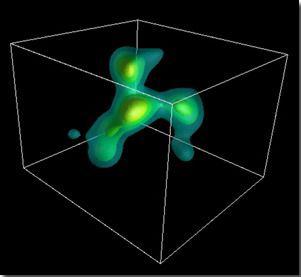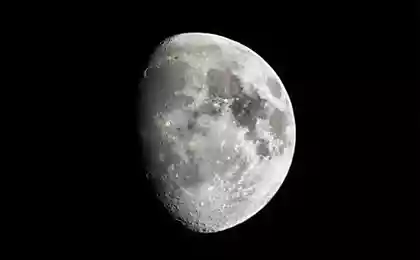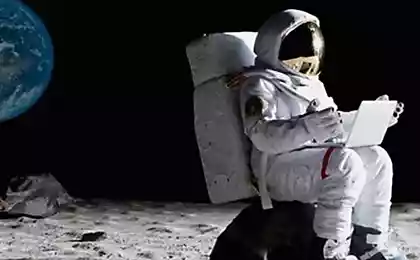985
6 of the most incredible things found in space (8 photos)
If you think about the cosmos - terribly boring place. In any case, it concerns our solar system. As neighbors we got unremarkable pieces of stone and balls of gas and stars from the nearest separate us light years of emptiness. Even Hollywood is not happy finds, by force of habit continued to inhabit the space copies of the Earth.
And yet in this space full of all sorts of things strikes the imagination, which is much more interesting creatures of fantasy writers. If you know where to look, you can easily find things like those included in our hit parade of cosmic oddities.

6. Diamond Planet

Sometimes it seems that the writers and the writers are able to fantasize on the strength of half a dozen different types of planets. Think for yourself: the icy planet (bright representative - Hoth from "Star Wars"), forest of the planet (Pandora from "Avatar"), desert planet, volcanic planet. Well, a couple more, another there.
Meanwhile, scientists have examined about 700 of these planets outside our solar system, and some of them could be a godsend for any scenario. Take, for PSR J1719-1438 b - wonderful planet that has nothing to do with all this rock-gas riffraff. Because it is literally made of diamond.
How is that possible?
Planet-diamond, which reportedly was not averse to buy Sheikh of Dubai, was once part of a double star. Most of the twin stars exploded, becoming a supernova. The explosion of the star couple were a pulsar and a white dwarf. And the dwarf stabilized just the right distance from his brother, cousin was able to assign the remnants of matter, but far enough to keep the carbon nucleus.
As you know, carbon should be nothing at all to turn into a diamond - just the right combination of temperature and pressure. In this particular case the conditions coincide, and former star of hardened, crystallized into a jewel on a planetary scale. It's amazing that humanity has not yet rallied in unison for a common goal: privoloch this baby to our house at any cost.
5. The huge rain cloud

Here's what you'll never see in films about space: water. Anyway, the "Millennium Falcon" was not the windshield wipers on, and a huge display "Enterprise" is not clouded by fog on the ship flew through the cosmic cloud. Yes, if you saw such a fantastic film, you would immediately protested: "Hey, these guys will ever have been in space ?!».
But do not jump to conclusions: Scientists have found the largest concentration of water vapor in the Universe - a huge cosmic cloud, drifting in space. And yes, when we say "huge" we do not mean "the size of the Pacific Ocean." We are talking about the size of 100 000 times the size of our Sun and about the amount of 140 trillion times more than all earthly water supplies.
How is that possible?
Epic proportions cloud water is 10 billion light years away, so it is unlikely that the next generation of astronauts will fly to him with flippers and swimming cap ready. Yet the scientists have an explanation for this phenomenon, they suggest that in the center of the cloud lingers massive black hole that eats everything around. But instead of throwing power, as do all decent black holes, this somehow gives off steam. Scientists still do not understand exactly how it does it, and why. So it may be that there is no black hole, and in the center of the cloud lies galactic scale water park.
4. Space lightning

Scientists have long figured out that lightning - not a unique phenomenon for the Earth. For example, they regularly observe Mars and Saturn. But until recently it was not known that lightning can occur not only in the atmosphere of the planets, but also right in the middle of outer Nothing, with the power of such discharges equals trillions of terrestrial lightning.
Excellent imagination electrical discharge was discovered near the galaxy 3C303 - the length of this "lightning" is estimated at 150 000 light-years, 50% longer than the Milky Way.
How is that possible?
Like most of the coolest space phenomena, caused by the discharge stage diva universal black hole. Astronomers believe that supermassive black hole at the center of 3C303, has an unusually strong magnetic field, which in turn generates electricity creating the largest electrical output, recorded by us in the universe.
3. Cold Star

The fact that the sun is very hot, we know almost from the cradle, but it is hot as we find out later. Its surface temperature is about 6,000 degrees Celsius, and the temperature of the corona, the upper part of the sun "atmosphere", can reach up to several million degrees.
But the tireless scientists have found that not all stars are so hot. First they found a star only 20 degrees hot cup of coffee - temperature of the light in 1458 under the name CFBDSIR 10b of 97 degrees Celsius. But five months later, astronomers have discovered another star with resort conditions: a star on the WISE 1828 + 2650 is quite possible to walk in shorts and a helmet, its surface temperature is only a 25 degrees Celsius.
How is that possible?
WISE 1828 + 2650 is part of a small group of cold stars, known as brown dwarfs. These children begin their lives as normal stars, but initially do not have enough mass. In fact, they are so small, that the stocks of the substance in them only enough to barely maintain the synthesis of hydrogen, resulting in a normal star emits light and heat. Frankly speaking, these poor fellows still consider the stars only out of sympathy.
2. Star 1500 times larger than the Sun

The easiest, what we face in our attempts to understand anything about the cosmos, this idea of the scale - in fact, the human imagination is simply afraid of the cosmic scope.
The sun is 109 times larger than Earth, and if we take the total weight of all the objects of our solar system, then it will have to share 99%, and that even with the giant Jupiter! Yet in comparison to other stars of our luminary in the younger group of kindergarten, so it is small.
Now imagine a star, which is greater than the sun as much as it is greater than our planet, and multiply this by five razmerchik. However, even if you get the stars expand into all of your monitor, and then compare it with the Sun could not have been. After all, our entire solar system would have been less than one pixel!
But what is this star is that? Meet: VY Canis Majoris, a red hyper giants with a diameter of about 2, 9 billion kilometers. The star is so huge that its own light would take 16 hours to fly around a swinger.
How is that possible?
"Hyper giants" of course, sounds cool, but in fact it is just a very big star. Although outstanding not only in terms of size but also in terms of luminosity - its brightness a million times the brightness of our sun. Why and how this star was blown up to this size, no one yet knows.
1. The enormous bubble of the early times

At school we were told that we are constantly traveling in time. Because even the sun in the sky - a model of an eight years ago, and each time, lifting his head up, we look into the past. And the more powerful our telescopes become, the more distant past of the universe we can see. And there are sometimes amazing things.

For example, this sort of thing. Giant-sized bulb length of 200 million light years. He is so far away that the light should be 12 billion light years to get from there to our outback, so that gizmo, we observe, formed just a couple of billion years after the Big Bang.
Within each of the "tentacles" of the sprawling space relic krakozyabry are galaxies and gas clouds, some length of 400 000 light years. Galaxy tightly clenched inside the giant structure, the average distance between them is 4 times less than between the majority of galaxies in the universe. Cool, is not it? But for all its uniqueness, scientists gave it the name of the formation of a completely unremarkable "galactic Proto EQ J221734.0 + 001 701".
And yet in this space full of all sorts of things strikes the imagination, which is much more interesting creatures of fantasy writers. If you know where to look, you can easily find things like those included in our hit parade of cosmic oddities.

6. Diamond Planet

Sometimes it seems that the writers and the writers are able to fantasize on the strength of half a dozen different types of planets. Think for yourself: the icy planet (bright representative - Hoth from "Star Wars"), forest of the planet (Pandora from "Avatar"), desert planet, volcanic planet. Well, a couple more, another there.
Meanwhile, scientists have examined about 700 of these planets outside our solar system, and some of them could be a godsend for any scenario. Take, for PSR J1719-1438 b - wonderful planet that has nothing to do with all this rock-gas riffraff. Because it is literally made of diamond.
How is that possible?
Planet-diamond, which reportedly was not averse to buy Sheikh of Dubai, was once part of a double star. Most of the twin stars exploded, becoming a supernova. The explosion of the star couple were a pulsar and a white dwarf. And the dwarf stabilized just the right distance from his brother, cousin was able to assign the remnants of matter, but far enough to keep the carbon nucleus.
As you know, carbon should be nothing at all to turn into a diamond - just the right combination of temperature and pressure. In this particular case the conditions coincide, and former star of hardened, crystallized into a jewel on a planetary scale. It's amazing that humanity has not yet rallied in unison for a common goal: privoloch this baby to our house at any cost.
5. The huge rain cloud

Here's what you'll never see in films about space: water. Anyway, the "Millennium Falcon" was not the windshield wipers on, and a huge display "Enterprise" is not clouded by fog on the ship flew through the cosmic cloud. Yes, if you saw such a fantastic film, you would immediately protested: "Hey, these guys will ever have been in space ?!».
But do not jump to conclusions: Scientists have found the largest concentration of water vapor in the Universe - a huge cosmic cloud, drifting in space. And yes, when we say "huge" we do not mean "the size of the Pacific Ocean." We are talking about the size of 100 000 times the size of our Sun and about the amount of 140 trillion times more than all earthly water supplies.
How is that possible?
Epic proportions cloud water is 10 billion light years away, so it is unlikely that the next generation of astronauts will fly to him with flippers and swimming cap ready. Yet the scientists have an explanation for this phenomenon, they suggest that in the center of the cloud lingers massive black hole that eats everything around. But instead of throwing power, as do all decent black holes, this somehow gives off steam. Scientists still do not understand exactly how it does it, and why. So it may be that there is no black hole, and in the center of the cloud lies galactic scale water park.
4. Space lightning

Scientists have long figured out that lightning - not a unique phenomenon for the Earth. For example, they regularly observe Mars and Saturn. But until recently it was not known that lightning can occur not only in the atmosphere of the planets, but also right in the middle of outer Nothing, with the power of such discharges equals trillions of terrestrial lightning.
Excellent imagination electrical discharge was discovered near the galaxy 3C303 - the length of this "lightning" is estimated at 150 000 light-years, 50% longer than the Milky Way.
How is that possible?
Like most of the coolest space phenomena, caused by the discharge stage diva universal black hole. Astronomers believe that supermassive black hole at the center of 3C303, has an unusually strong magnetic field, which in turn generates electricity creating the largest electrical output, recorded by us in the universe.
3. Cold Star

The fact that the sun is very hot, we know almost from the cradle, but it is hot as we find out later. Its surface temperature is about 6,000 degrees Celsius, and the temperature of the corona, the upper part of the sun "atmosphere", can reach up to several million degrees.
But the tireless scientists have found that not all stars are so hot. First they found a star only 20 degrees hot cup of coffee - temperature of the light in 1458 under the name CFBDSIR 10b of 97 degrees Celsius. But five months later, astronomers have discovered another star with resort conditions: a star on the WISE 1828 + 2650 is quite possible to walk in shorts and a helmet, its surface temperature is only a 25 degrees Celsius.
How is that possible?
WISE 1828 + 2650 is part of a small group of cold stars, known as brown dwarfs. These children begin their lives as normal stars, but initially do not have enough mass. In fact, they are so small, that the stocks of the substance in them only enough to barely maintain the synthesis of hydrogen, resulting in a normal star emits light and heat. Frankly speaking, these poor fellows still consider the stars only out of sympathy.
2. Star 1500 times larger than the Sun

The easiest, what we face in our attempts to understand anything about the cosmos, this idea of the scale - in fact, the human imagination is simply afraid of the cosmic scope.
The sun is 109 times larger than Earth, and if we take the total weight of all the objects of our solar system, then it will have to share 99%, and that even with the giant Jupiter! Yet in comparison to other stars of our luminary in the younger group of kindergarten, so it is small.
Now imagine a star, which is greater than the sun as much as it is greater than our planet, and multiply this by five razmerchik. However, even if you get the stars expand into all of your monitor, and then compare it with the Sun could not have been. After all, our entire solar system would have been less than one pixel!
But what is this star is that? Meet: VY Canis Majoris, a red hyper giants with a diameter of about 2, 9 billion kilometers. The star is so huge that its own light would take 16 hours to fly around a swinger.
How is that possible?
"Hyper giants" of course, sounds cool, but in fact it is just a very big star. Although outstanding not only in terms of size but also in terms of luminosity - its brightness a million times the brightness of our sun. Why and how this star was blown up to this size, no one yet knows.
1. The enormous bubble of the early times

At school we were told that we are constantly traveling in time. Because even the sun in the sky - a model of an eight years ago, and each time, lifting his head up, we look into the past. And the more powerful our telescopes become, the more distant past of the universe we can see. And there are sometimes amazing things.

For example, this sort of thing. Giant-sized bulb length of 200 million light years. He is so far away that the light should be 12 billion light years to get from there to our outback, so that gizmo, we observe, formed just a couple of billion years after the Big Bang.
Within each of the "tentacles" of the sprawling space relic krakozyabry are galaxies and gas clouds, some length of 400 000 light years. Galaxy tightly clenched inside the giant structure, the average distance between them is 4 times less than between the majority of galaxies in the universe. Cool, is not it? But for all its uniqueness, scientists gave it the name of the formation of a completely unremarkable "galactic Proto EQ J221734.0 + 001 701".























